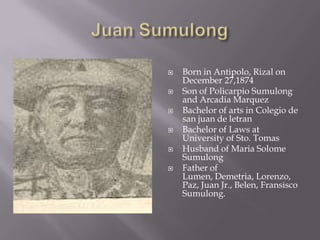
Juan Sumulong
- 1. Juan Sumulong Born in Antipolo, Rizal on December 27,1874 Son of PolicarpioSumulong and Arcadia Marquez Bachelor of arts in Colegio de san juan de letran Bachelor of Laws at University of Sto. Tomas Husband of Maria SolomeSumulong Father of Lumen, Demetria, Lorenzo, Paz, Juan Jr., Belen, FransiscoSumulong.
- 2. Juan Sumulong He was married to a distant cousin, Maria Salome Sumulong. They had 11 children, four of whom died, the seven surviving being Lumen, Demetria, Lorenzo, Paz, Juan Jr., Belen and Francisco.
- 3. Juan Sumulong When the Revolution against Spain broke out ,he joined the revolutionists with headquarters in Morong Province (now Rizal). After the restoration or peace following the Filipino-American War, he served as a private secretary to the Filipino civil governor of Morong Province with headquarters in Antipolo. In a meeting held at the Pasig Church on June 5, 1901 to discuss the fusion of Morong Province and the Province of Manila, councilorSumulong spoke in favor of such a union. It was ultimately approved and the new province was named Rizal. He became a journalist, joining La Patria as a reporter and becoming its city editor after three months. He analyzed the political situations for La Democracia, the Federal Party’s official publication, of which he was the editor for a long time.
- 4. Juan Sumulong One of the first cases he handled was the boundary dispute between Antipolo and the neighboring town of Cainta. He won case for his hometown He and Rafael Palma also successfully defended the newspaper El Renacimiento in a libel suit filed by some American Constabulary officials. The paper exposed the abuses committed by the military officers against the peaceful citizens of Cavite in the concentration camp in Bacoor. It was the first case that the American government lost. In June 1902, these two young lawyers secured from Governor William Howard Taft the pardon of Isabelo de los Reyes who was accused of “conspiracy” in organizing a labor union which staged the first organized strike in the Philippines
- 5. Juan Sumulong Sumulong was vice-president of the PartidoNacionalProgresista that was organized on January 2, 1907. The new political party aimed to achieve Philippine Independence by progressive stages. He ran as its candidate for a seat in the first Philippine Assembly in the July 30 elections, but lost to the Nacionalist Party candidate. Again, he ran for, and lost the position of senator for the fourth district in the 1916 general elections. Sumulong was an effective “public speaker with a high reputation for intellectual capacity and integrity” according to Claro M. Recto, Jr.. But he lost his senatorial bid in 1923 because of an alleged defect in the party platform. In 1925, he was elected finally to a six-year term as Senator for the fourth district, composed of Manila, Rizal, Laguna and Bataan.
- 6. Juan Sumulong As senator, he had his famous debate with Senate President Manuel L. Quezon on the amendments to the Corporation Law. He also voiced out his vehement opposition to the enactment of the Belo Act, giving the Governor-General a yearly appropriation fund for military and technical advisers known as the Belo Boys. He authored the law creating the gasoline tax and the law regarding the books of accounts to be kept by merchants, especially by Chinese. From 1930 to 1931, he was in the United States as a member of the Philippine Independence Mission. When the first Philippine Independence Act, known as the Hare-Hawes Cutting Act, was enacted by the U.S. Congress, he decided to oppose its acceptance by the Filipino people mainly because of its provision that even after Philippine independence, the United States will continue to exercise sovereignty over U.S. Military reservations in the Philippines. Quezon, Aguinaldo, Recto and many others opposed the HHC Act and they became known as the Antis. Osmena, Roxas, and others favoring it became known as the Pros.
- 7. Juan Sumulong Due to poor health, he resigned from the presidency of the Democrata Party on the eve of the election on June 2, 1931. His resignation led to the dissolution of the party. In the election of June 5, 1934, he ran as the candidate of the Antis, for Senator of the fourth senatorial district. He won and the Antis became the party in power. On August 18, the Nacionalista and Democrata “Antis” fused into a new political party called PartidoNacionalistaDemocrata with Quezon as president and Sumulong as vice-president. The coalition in 1935 of this party and the opposition party of Osmena was bitterly denounced by Sumulong in his manifesto called After the Coalition, the Deluge. He believed that political representation was imbalanced and that the coalition would to an oligarchy and to the development of a revolutionary opposition. This was already evident, he warned, in the growth of Communism and Sakdalism. The Sakdal uprising in May 1935 lent credence to Sumulong’s warnings
- 8. Juan Sumulong Sumulong, who long before Quezon adopted the slogan of “social justice”, broke up with the latter and continued keeping alive an opposition
- 9. Juan Sumulong In 1941, he ran against Quezon for the Presidency in spite of his failing health. Two weeks before the elections, he fell ill and was forced to stay in bed until his death on January 9, 1942. Several hours before his death he told Jorge Bocobo and Jose Fabella that he and his party would not join in the formation of a Japanese – sponsored government.
- 10. Group members Ulgado, Ivan Eduardo A. Mendoza, Louie Bryan M. Bagatsolan, Alecx Andrea S. Magnate, Hania Marie L. Albesor, Karen Camille R. Sotalbo, Darlene S. Caldo, Klaudine Ann P. Bañagale, Jashline Ann A. Talento, Mara Sherlin D.